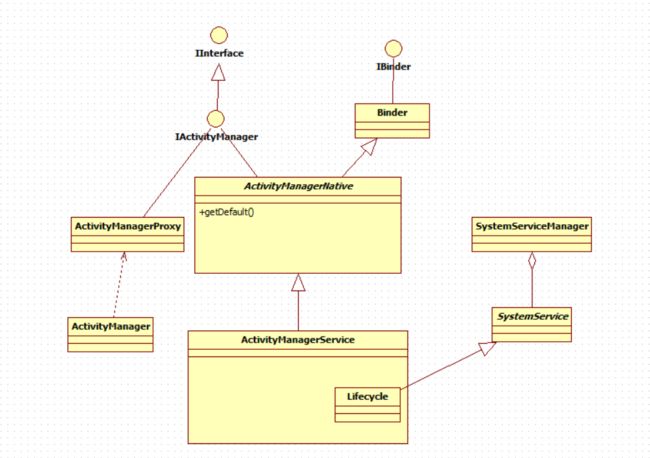1、相关类简述
1.1、com.android.server.SystemServer
本身由zygote进程运行,用来启动各种各样的系统服务(SystemService)
1.2、com.android.server.SystemService
运行在系统进程中的service,每个SystemService都是有生命周期的,所有的生命周期函数都是运行在SystemServer的主线程当中。
1.2.1 每个SystemService都有一个参数为Context的构造函数,用来初始化SystemService;
1.2.2 调用onstart()使得SystemService处于运行状态,在这种状态下,该SystemService可以通过publishBinderService(String, IBinder) 方法来向外提供服务(binder interface),
1.2.3 在启动阶段onBootPhase(int)会被不停的调用直到运行到PHASE_BOOT_COMPLETED阶段(启动阶段的最后阶段),在启动的每一阶段都可以完成一些特殊的任务。
1.3、 com.android.server.SystemServiceManager
负责管理SystemService的创建、启动以及其他生命周期函数
1.4、android.app.ActivityManager
用来和系统中所有运行的Activity进行交互,运行在用户进程中;
IActivityManager是一个系统服务,对于上层应用,IActivityManager不希望把所有的接口都暴露出来,因而使用ActivityManager作为中介来访问IActivityManager提供的功能。ActivityManager是通过ActivityManagerNative.getDefault()来获取到IActivityManager这个接口的。因为ActivityManager是运行在用户进程的,因而getDefault()获取的是ActivityManagerProxy.
2、com.android.server.am.ActivityManagerService
2.1 简单类图
对于使用过AIDL并且看过.aidl文件自动生成的java类的人来说,这个不要太熟悉了,IActivityManager对应自定义的接口,ActivityManagerNative对应Stub,ActivityManagerProxy对应Stub中的proxy,ActivityManagerService对应的就是真正的接口实现者。
可以看到ActivityManagerService并不是一个SystemService,真正的SystemService是它里面的内部类Lifecycle,而Lifecycle持有ActivityManagerService的实例并且其生命周期都是由ActivityManagerService来替代完成的。这样设计,一来使得ActivityManagerService具有SystemService具有的一切特征,二来可以向调用者比如ActivityManager提供特定的功能。
2.2 ActivityManagerService初始化过程
// Activity manager runs the show.
mActivityManagerService = mSystemServiceManager.startService(
ActivityManagerService.Lifecycle.class).getService();
public static final class Lifecycle extends SystemService {
private final ActivityManagerService mService;
public Lifecycle(Context context) {
super(context);
// init ActivityManagerService
mService = new ActivityManagerService(context);
}
@Override
public void onStart() {// 启动该SystemService
mService.start();
}
public ActivityManagerService getService() {
return mService;
}
}
这里的Lifecycle是一个SystemService,内部持有一个ActivityManagerService实例。
2.3 ActivityManagerService构造函数
// Note: This method is invoked on the main thread but may need to attach various
// handlers to other threads. So take care to be explicit about the looper.
// 该构造函数是运行在主线程中的,其里面会有其他的子线程用来完成相关任务
public ActivityManagerService(Context systemContext) {
mContext = systemContext;//系统进程中的Context
mFactoryTest = FactoryTest.getMode();
// 系统进程(framework-res.apk)对应的ActivityThread
mSystemThread = ActivityThread.currentActivityThread();
Slog.i(TAG, "Memory class: " + ActivityManager.staticGetMemoryClass());
// 创建了一个ServiceThread(HandlerThread)
mHandlerThread = new ServiceThread(TAG,
android.os.Process.THREAD_PRIORITY_FOREGROUND, false /*allowIo*/);
mHandlerThread.start();
// 创建一个Handler,使用的是ServiceThread的Looper
mHandler = new MainHandler(mHandlerThread.getLooper());
// 创建了一个UiHandler,它的Looper是mainLooper
mUiHandler = new UiHandler();
mFgBroadcastQueue = new BroadcastQueue(this, mHandler,
"foreground", BROADCAST_FG_TIMEOUT, false);
mBgBroadcastQueue = new BroadcastQueue(this, mHandler,
"background", BROADCAST_BG_TIMEOUT, true);
mBroadcastQueues[0] = mFgBroadcastQueue;
mBroadcastQueues[1] = mBgBroadcastQueue;
mServices = new ActiveServices(this);
mProviderMap = new ProviderMap(this);
// TODO: Move creation of battery stats service outside of activity manager service.
File dataDir = Environment.getDataDirectory();
File systemDir = new File(dataDir, "system");
systemDir.mkdirs();
mBatteryStatsService = new BatteryStatsService(systemDir, mHandler);
mBatteryStatsService.getActiveStatistics().readLocked();
mBatteryStatsService.scheduleWriteToDisk();
mOnBattery = DEBUG_POWER ? true
: mBatteryStatsService.getActiveStatistics().getIsOnBattery();
mBatteryStatsService.getActiveStatistics().setCallback(this);
mProcessStats = new ProcessStatsService(this, new File(systemDir, "procstats"));
mAppOpsService = new AppOpsService(new File(systemDir, "appops.xml"), mHandler);
mGrantFile = new AtomicFile(new File(systemDir, "urigrants.xml"));
// User 0 is the first and only user that runs at boot.
mStartedUsers.put(UserHandle.USER_OWNER, new UserState(UserHandle.OWNER, true));
mUserLru.add(UserHandle.USER_OWNER);
updateStartedUserArrayLocked();
GL_ES_VERSION = SystemProperties.getInt("ro.opengles.version",
ConfigurationInfo.GL_ES_VERSION_UNDEFINED);
mTrackingAssociations = "1".equals(SystemProperties.get("debug.track-associations"));
mConfiguration.setToDefaults();
mConfiguration.setLocale(Locale.getDefault());
mConfigurationSeq = mConfiguration.seq = 1;
mProcessCpuTracker.init();
mCompatModePackages = new CompatModePackages(this, systemDir, mHandler);
mIntentFirewall = new IntentFirewall(new IntentFirewallInterface(), mHandler);
// 最近任务列表
mRecentTasks = new RecentTasks(this);
//
mStackSupervisor = new ActivityStackSupervisor(this, mRecentTasks);
//
mTaskPersister = new TaskPersister(systemDir, mStackSupervisor, mRecentTasks);
mProcessCpuThread = new Thread("CpuTracker") {
@Override
public void run() {
while (true) {
try {
try {
synchronized(this) {
final long now = SystemClock.uptimeMillis();
long nextCpuDelay = (mLastCpuTime.get()+MONITOR_CPU_MAX_TIME)-now;
long nextWriteDelay = (mLastWriteTime+BATTERY_STATS_TIME)-now;
//Slog.i(TAG, "Cpu delay=" + nextCpuDelay
// + ", write delay=" + nextWriteDelay);
if (nextWriteDelay < nextCpuDelay) {
nextCpuDelay = nextWriteDelay;
}
if (nextCpuDelay > 0) {
mProcessCpuMutexFree.set(true);
this.wait(nextCpuDelay);
}
}
} catch (InterruptedException e) {
}
updateCpuStatsNow();
} catch (Exception e) {
Slog.e(TAG, "Unexpected exception collecting process stats", e);
}
}
}
};
Watchdog.getInstance().addMonitor(this);
Watchdog.getInstance().addThread(mHandler);
}
2.4 ActivityManagerservice.setSystemProcess()
// Set up the Application instance for the system process and get started.
// 初始化系统进程的Application并启动它
mActivityManagerService.setSystemProcess();
public void setSystemProcess() {
try {
// 向ServiceManager中注册各种服务
ServiceManager.addService(Context.ACTIVITY_SERVICE, this, true);
ServiceManager.addService(ProcessStats.SERVICE_NAME, mProcessStats);
ServiceManager.addService("meminfo", new MemBinder(this));
ServiceManager.addService("gfxinfo", new GraphicsBinder(this));
ServiceManager.addService("dbinfo", new DbBinder(this));
if (MONITOR_CPU_USAGE) {
ServiceManager.addService("cpuinfo", new CpuBinder(this));
}
ServiceManager.addService("permission", new PermissionController(this));
ServiceManager.addService("processinfo", new ProcessInfoService(this));
// AndroidManifes.xml中标签解析出来的配置信息保存在这个对象中
// 从PackageManagerService中获取framework-res.apk安装包的ApplicationInfo信息
// 注意这里的使用方式,PackageManagerService和ActivityManagerService运行在同一个进程
// 这里为什么要使用跨进程的方式来进行通信呢?
// 原因是保持android环境中和服务交互的一致性,利于以后扩展和维护
ApplicationInfo info = mContext.getPackageManager().getApplicationInfo(
"android", STOCK_PM_FLAGS);
//
mSystemThread.installSystemApplicationInfo(info, getClass().getClassLoader());
synchronized (this) {
// 生成保存系统进程信息的对象
ProcessRecord app = newProcessRecordLocked(info, info.processName, false, 0);
// 保持该进程一直处于运行状态
app.persistent = true;
app.pid = MY_PID;
app.maxAdj = ProcessList.SYSTEM_ADJ;
// 给该进程对象设置该进程中AMS和其他进程交互的接口
app.makeActive(mSystemThread.getApplicationThread(), mProcessStats);
synchronized (mPidsSelfLocked) {
mPidsSelfLocked.put(app.pid, app);
}
updateLruProcessLocked(app, false, null);
updateOomAdjLocked();
}
} catch (PackageManager.NameNotFoundException e) {
throw new RuntimeException(
"Unable to find android system package", e);
}
}
2.4.1 ActivityThread.installSystemApplicationInfo()
public void installSystemApplicationInfo(ApplicationInfo info, ClassLoader classLoader) {
synchronized (this) {
// ContextImpl.installSystemApplicationInfo()
// info:framework-res.apk androidmanifest.xml application标签相关信息
getSystemContext().installSystemApplicationInfo(info, classLoader);
// give ourselves a default profiler
mProfiler = new Profiler();
}
}
ContextImpl.installSystemApplicationInfo()
void installSystemApplicationInfo(ApplicationInfo info, ClassLoader classLoader) {
mPackageInfo.installSystemApplicationInfo(info, classLoader);
}
LoadedAPK.installSystemApplicationInfo()
/**
* Sets application info about the system package.
*/
void installSystemApplicationInfo(ApplicationInfo info, ClassLoader classLoader) {
assert info.packageName.equals("android");
mApplicationInfo = info;
mClassLoader = classLoader;
}
ActivityManagerservice.setSystemProcess()做的第一件事情是:从PackageManagerService中找到packageName为"android"(framework-res.apk)对应的ApplicationInfo信息,然后填充到apk对应的LoadedApk对象中。从PackageManagerService分析中了解到在系统启动的时候会扫描并解析APK把信息保存到它自己的Map中,所以这里直接从这个map中直接取出来,然后从android系统Context初始化过程中知道,对于packagename为"android"的framework-res.apk,其ApplicationInfo在LoadedApk构造函数中是直接new出来的,是一个空的对象,因而这里从PackageManagerService取出来填充到这里。
2.4.2 ActivityManagerservice.newProcessRecordLocked():创建一个ProcessRecord对象,用来保存系统进程信息
final ProcessRecord newProcessRecordLocked(ApplicationInfo info, String customProcess,
boolean isolated, int isolatedUid) {
// 进程名
String proc = customProcess != null ? customProcess : info.processName;
// 耗电量统计
BatteryStatsImpl stats = mBatteryStatsService.getActiveStatistics();
final int userId = UserHandle.getUserId(info.uid);
int uid = info.uid;
if (isolated) {// 对系统进程该值为false
if (isolatedUid == 0) {
int stepsLeft = Process.LAST_ISOLATED_UID - Process.FIRST_ISOLATED_UID + 1;
while (true) {
if (mNextIsolatedProcessUid < Process.FIRST_ISOLATED_UID
|| mNextIsolatedProcessUid > Process.LAST_ISOLATED_UID) {
mNextIsolatedProcessUid = Process.FIRST_ISOLATED_UID;
}
uid = UserHandle.getUid(userId, mNextIsolatedProcessUid);
mNextIsolatedProcessUid++;
if (mIsolatedProcesses.indexOfKey(uid) < 0) {
// No process for this uid, use it.
break;
}
stepsLeft--;
if (stepsLeft <= 0) {
return null;
}
}
} else {
// Special case for startIsolatedProcess (internal only), where
// the uid of the isolated process is specified by the caller.
uid = isolatedUid;
}
}
// 创建ProcessRecord,用于存储系统进程所在进程的所有信息
final ProcessRecord r = new ProcessRecord(stats, info, proc, uid);
if (!mBooted && !mBooting
&& userId == UserHandle.USER_OWNER
&& (info.flags & PERSISTENT_MASK) == PERSISTENT_MASK) {
r.persistent = true;
}
// 添加ProcessRecord 到Map中保存起来
addProcessNameLocked(r);
return r;
}
2.4.3 ApplicationThread简要介绍
首先看类图:
ApplicationThread具备IApplicationThread所有的能力,是AMS与其他应用交互的桥梁,ActivityThread里面通过mAppThread属性指向它。
以上,便是ActivityManagerservice.setSystemProcess()的主要工作:一是从PackageManagerService中找到系统APK(framework-res.apk)对应的ApplicationInfo信息,填充到和它对应的LoadedApk对象中;二是创建一个记录其进程信息的对象ProcessRecord并关联IApplicationThread,使得该进程中的AMS能够和其他进程进行交互。
2.5 ActivityManagerService.installSystemProviders();
public final void installSystemProviders() {
List providers;
synchronized (this) {
// 获取进程名为"system",进程 UID为1000的进程
// 在PMS的Settings中可以知道该进程共享名为"android.uid.system"
ProcessRecord app = mProcessNames.get("system", Process.SYSTEM_UID);
// 找到该进程中的所有contentprovider对应的信息ProviderInfo
providers = generateApplicationProvidersLocked(app);
if (providers != null) {
for (int i=providers.size()-1; i>=0; i--) {
ProviderInfo pi = (ProviderInfo)providers.get(i);
if ((pi.applicationInfo.flags&ApplicationInfo.FLAG_SYSTEM) == 0) {
Slog.w(TAG, "Not installing system proc provider " + pi.name
+ ": not system .apk");
providers.remove(i);
}
}
}
}
if (providers != null) {
// ActivityThread对ContentProvider进行安装
mSystemThread.installSystemProviders(providers);
}
mCoreSettingsObserver = new CoreSettingsObserver(this);
//mUsageStatsService.monitorPackages();
}
framework-res.apk中AndroidManifest.xml文件相关配置:
//..........
//.........
SettingProvider.apk 中AndroidManifest.xml内容
从xml文件中可以发现,frameworkwork-res.apk和SettingProvider都运行在名为system的进程中,在2.4中那个创建出来的ProcessRecord以及这里要找的ProcessRecord都是指向这个进程,从清单文件中可以看到,framework-res.apk中是没有provider的,只有settingprovider中有一个,所以这里找到的就是settingprovider中的contentprovider对应的信息ProviderInfo。
在查询到了该进程contentprovider对应的信息后,通过ActivityThread的installSystemProviders()来对其进行安装。查询的详细过程和安装的过程这里略过,这个暂时不是我的重点~~
2.6 ActivityManagerService.systemReady(Runnable callback)
这个方法主要作用是:
1)发送Intent.ACTION_PRE_BOOT_COMPLETED广播,该广播只会被处理一次,接受者接收该广播主要是对数据库做一些处理;
2)清理在启动过程中启动的非persistent进程,persistent进程是需要一直保持运行的进程;
3)读取设置信息:需要调试的程序包名,等待调试的应用,字体大小相关等等
4)加载资源信息
5)运行回调:允许观察native crash了,启动SystemUI.apk等等其他服务;
6)启动persistent应用,启动Launcher.
2.7 Launcher启动过程
ActivityManagerService.startHomeActivityLocked()
boolean startHomeActivityLocked(int userId, String reason) {
if (mFactoryTest == FactoryTest.FACTORY_TEST_LOW_LEVEL
&& mTopAction == null) {
// We are running in factory test mode, but unable to find
// the factory test app, so just sit around displaying the
// error message and don't try to start anything.
return false;
}
// 取得Launcher对应的Intent
Intent intent = getHomeIntent();
// 从PackageManagerService中取得Launcher对应的信息
ActivityInfo aInfo =
resolveActivityInfo(intent, STOCK_PM_FLAGS, userId);
if (aInfo != null) {
intent.setComponent(new ComponentName(
aInfo.applicationInfo.packageName, aInfo.name));
// Don't do this if the home app is currently being
// instrumented.
aInfo = new ActivityInfo(aInfo);
aInfo.applicationInfo = getAppInfoForUser(aInfo.applicationInfo, userId);
// Launcher运行进程信息
ProcessRecord app = getProcessRecordLocked(aInfo.processName,
aInfo.applicationInfo.uid, true);
// 如果Launcher没有启动,则启动它
if (app == null || app.instrumentationClass == null) {
//
intent.setFlags(intent.getFlags() | Intent.FLAG_ACTIVITY_NEW_TASK);
//mStackSupervisor初始化在构造函数中,启动Launcher
mStackSupervisor.startHomeActivity(intent, aInfo, reason);
}
}
return true;
}

